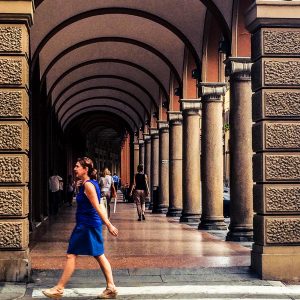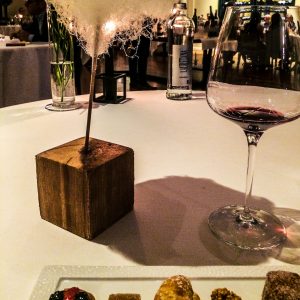When people think of holidaying in Italy the most popular Google search terms are Florence, Venice, Pisa, and of course, Rome. There is nothing wrong with these places, but there are so many more places to see, arguably better places, beyond the clichés. Don’t let Google’s algorithms lead you down the touristic beaten path: Italy has so much more to offer, from Puglia in the south, the relatively unspoilt Le Marche region in the middle, to cities like Turin in the north – each with their own specialities, eccentricities and idiosyncrasies. In this piece we focus on the underrated city of Bologna and explain why this should be on every food lover’s bucket list.

The famous portici of Bologna
Bologna has been described as Italy’s capital of gastronomy. Of course, if one is truly pedantic, the concept of “Italian food” doesn’t really exist in a country where the cuisine is so devoutly regional. But in a figurative sense, Bologna is certainly the daddy. No doubt you will be familiar with tagliatelle al ragu, Parmigiano Reggiano and Prosciutto di Parma – yep, these all come from Bologna and its surrounds. And merely 20 minutes away from Bologna is Modena, the home of balsamic vinegar (where tastings can be easily arranged in the local acetaia) and Osteria Francescana, formerly the world’s best restaurant until just this year (it has since slipped to second place, according to The World’s 50 Best Restaurants). With so many gastronomic delights in such close proximity to each other, it’s amazing really how Bologna gets so easily overlooked.
Located in the Emilia-Romagna area of Italy, Bologna is easy to get to for a weekend break with cheap flights available from Stansted airport. It’s also only an hour away from Milan by train. Perhaps because of its landlocked location and lack of wind-chill, the ‘red city’ is aptly-named – not just because of its left-leaning precocious politics, but it tends to get bakingly hot in summer, which is when I went. With its ruddy architecture you can feel like you’re being cooked alive in a terracotta casserole pot, so it is recommended you stay and dine anywhere with fully functioning air con.
One thing is for sure: you will eat extremely well in Bologna
Walking around, you cannot ignore the youthful, student vibe of the place. It is home to Europe’s first ever university and the spirit of academia lives on – the famous ‘portici’, which you see and walk through everywhere in Bologna, are reminiscent of an Oxbridge college, and the streets are alive with live music. Bologna is very easy to walk around too – just step out of the central station and already you’re heading down the via dell’Indipendenza, lined with its shops and trattoria, towards the Piazza Maggiore and the Two Towers in the heart of the city.

Via Rizzoli, heading towards the Two Towers
Right, that’s the Lonely Planet stuff done. Let’s get down to the food. One thing is for sure: you will eat extremely well in Bologna. Even with just the ‘street food’ you can’t go far wrong really with ordering a piadina with mortadella (the local flatbread sandwich), biting into that sumptuous hamminess, take a pew in the Parco della Montagnola or soak up the atmosphere of the Piazza Maggiore with your sundowner Aperol Spritz.
And then there is of course the aforementioned tagliatelle al ragu. This, of course, must never, ever be confused with the ‘Spag Bol’ we Brits have come to know and strangely love which is, I’m afraid, a bastardisation – a cheap knock-off version of the real thing. So, trying the most authentic version in Bologna is an absolute must – even a rite of passage. Of course, there are as many recipes for this as there are people, but there are certain cardinal principles that are common to all. I was lucky enough to spend a morning with a local chef who explained his approach (as handed down to him from his mother, and countless generations before that).
The resulting ragu was absolutely gorgeous – Class A in its moreishness

Making tagliatelle from scratch with a local chef
Starting with the dough for the tagliatelle (known as the sfoglia), he explained that it’s crucial that the eggs are very fresh and come from the Emilia-Romagna area where the chickens feed on corn – this leads to a rich, yellowy pasta. You just cannot beat freshly made pasta (hand-rolled on a wooden surface too, no cheating with machines), and for this dish only tagliatelle will do. Spaghetti is only acceptable for seafood dishes or simple sauces like pesto or a tomato sugo – for a meaty ragu though, spaghetti is sacrilege. The meat should hold on to the ribbons of pasta like a needy, clingy pet clutches its owner’s legs for attention, not fall off and plonk into an acidic pond of tomatoey rejection like the British version. As for the ragu sauce, this is slow-cooked for at least two hours so that the meat breaks down and achieves maximum unctuosity. It was fascinating to watch, and indeed help, in the making of this sauce. First off, there’s the soffritto: chopping up carrot, celery and onion, throwing them into a frying pan and sweating them off in that order. Then in goes chopped pancetta (freshly bought from the market), followed by cartella, which is beef from the diaphragm of the cow. The meat is seasoned then browned for a few minutes before a crucial glug of red wine is added. Once this has reduced, in goes the chopped tomato and tomato puree, which is left to simmer. Towards the end, a small bit of milk is added to counteract some of the tomato’s acidity. The resulting ragu was absolutely gorgeous – Class A in its moreishness.
As for specific restaurants, Bologna does have its fair share of tourist traps you should avoid. Quite a few of these are dotted around the student quarter. I had a rather sloppy carbonara in one of these, where the sauce had evidently been made with cream (a big no no!) and some non-descript ham rather than guanciale.
But such places are the exception really. Two restaurants in particular stood out and should be on your Bologna to do list. Ristorante Pappagallo is an institution in Bologna, located just on the edge of the university district and at the base of the Two Towers. Here you can have traditional Bologenese fare for a very decent price. The 5 course set menu is just 59 Euros. I opted for the tortellini in chicken broth, followed by veal. There was no particular ‘wow factor’ about these dishes which is probably why those Michelin stars remain elusive: the main dish was essentially just a slab of meat on a blob of mashed potato, with some pan jus artfully dribbled over. The veal was cooked almost perfectly – just ever-so-slightly tough but mostly fine. No panache, nothing brave or ground-breaking, but at least it was packed full of flavour and competently prepared. Although many of the other customers were Anglophones, I discerned some discerning locals, so their endorsement was all the reassurance I needed.
Ambience-wise, it was a little bland with the walls painted in a shade of paint I’m sure Dulux would never have green-lit (somewhere between ricotta and a milky caffe latte). The lighting was perhaps a tad too bright for my liking and the black and white pictures of film actors and celebs of yesteryear a little clichéd now. Seating was comfortable though and tables spaced apart reasonably. No complaints about the service: it was efficient and functional but not overtly friendly – it did cross my mind that Brexit might be to blame for that, but to be honest all the Italians I met were absolutely lovely.
As for the more high-end places, you might be surprised by the lack of Michelin coverage in Bologna, but I think that says more about the Michelin guide really. Bologna’s only restaurant deigned worthy of a Michelin star, I Portici, certainly impressed. Bearing in mind it’s housed in the hotel of the same name, which attracts local business types living on their corporate expenses, it was no surprise to see a few tables of suited and booted folk. This slight air of formality is off-set by the quirky surroundings: the restaurant was once a concert hall, and the stage and gallery remain to this day, but it has been tastefully renovated so it doesn’t feel like a school assembly hall. The only disappointment was seeing the piano on the stage, left unplayed. It looked so full of promise.

The bizarre candy floss at I Portici
I was served all the usual freebies you expect of a one star restaurant these days, which frankly don’t impress me much: amuse bouches, several different species of bread, and an array of sweet petits fours to go with my coffee, the most absurd of which was a monstrous feather duster of candy floss. I told the waiter he could keep it – perhaps dust the cobwebs off the forgotten piano with it, I don’t know.
I Portici offers four 6 course tasting menu options, each at 80 Euros a-piece – the meat one, the fish one, the combined meat and fish, and the veggie one, so it caters for everyone. My starter of a rabbit ravioli, which was more like the local tortellini, was very small indeed – just three small pieces, with a provolone sauce and little bits of seaweed on top – sounds odd, but it looked elegant and tasted beguilingly good. My only complaint is there wasn’t enough of it! My main of pork – just a sliver the size of a lady finger, with crackling on it, and little dollops on the side and cubes of celeriac, was also parsimonious in its size, and didn’t really feel that Italian to be honest. Perhaps, I suspect, catering to an international crowd.
There was an unexplained delay serving my espresso and with the presentation of the bill, but other than that, service was good and attentive. The sommelier was calm under my questioning, not too pushy, and the wines by the glass he suggested did indeed complement each of my courses. Overall, a good restaurant for sure, and definitely worth stopping off here after a day walking around this fantastic city.
So go on, what are you waiting for? Add Bologna to your to do list!
Ristorante Pappagallo
Piazza della Mercanzia
40125 Bologna
Italy
I Portici
Via dell'Indipendenza
40121 Bologna
Italy
April 2017






